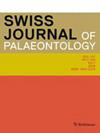约1亿年前的化石证明了未成熟土蜈蚣和类蚜虫幼虫抓握结构的趋同进化和趋同丧失
IF 3
2区 地球科学
Q1 PALEONTOLOGY
引用次数: 0
摘要
趋同进化是一种普遍现象,在不同的进化谱系中独立地导致相似的形态。通常类似的功能需求驱动趋同进化。一个例子是不同谱系的真节肢动物的抓握结构的独立进化,尽管这些抓握结构的确切形态差异很大。本研究研究了具有两种可移动的对抗结构的抓握器及其相关结构,如麻翅目草翅类蚜虫幼虫的花柱(口器的复合结构)和皮翅目未成熟土蜈蚣的尾蚴。研究指出,在过去的1亿年里,像飞虱一样的幼虫的柱头在形态多样性上有了显著的丧失。我们使用定量形态学来评估是否在蠼螋的cerci中也发生了类似的过程。现存未成熟蠼螋的尾须在现代动物群中表现出两种截然不同的形态:细长的尾须分为几个具有触角型功能的小卷;钳状的粗壮尾须。然而,在一些未成熟的土蚣化石中,尾毛一般是细长的,但不分裂,大致占据两种现代尾毛类型之间的形态空间;因此,这种化石尾蚴的形态似乎已经丢失了。在某种程度上,在某些草蛉幼虫中也发现了类似的损失。外群比较表明,今天不再存在的形态实际上不是祖先的,而是专门的,因此它们的消失可能是由于蠼螋和草蛉的破坏性进化造成的。我们讨论了这些特殊抓握结构的可能功能。本文章由计算机程序翻译,如有差异,请以英文原文为准。
Convergent evolution and convergent loss in the grasping structures of immature earwigs and aphidlion-like larvae as demonstrated by about 100-million-year-old fossils
Abstract Convergent evolution is a common phenomenon, independently leading to similar morphologies in different evolutionary lineages. Often similar functional demands drive convergent evolution. One example is the independent evolution of grasping structures in different lineages of Euarthropoda, though the exact morphology of these grasping structures varies significantly. In this study, we investigated grasping apparatuses with two movable counteracting structures as well as some related structures, exemplified by the stylets (compound structures of mouthparts) of aphidlion-like larvae (part of Neuroptera or lacewings) and the cerci of immature earwigs (Dermaptera). For the stylets of aphidlion-like larvae, studies have pointed to a significant loss in morphological diversity in the last 100 million years. We used quantitative morphology to evaluate if a similar process has also occurred in the cerci of earwigs. The cerci of extant immature earwigs exhibit two distinct types of morphologies in the modern fauna: elongated cerci divided into several ringlets with a feeler-type function, and pincer-like stout cerci. In some fossil immature earwigs, however, the cerci are generally elongated but undivided and roughly occupy the morphospace between those of the two modern cerci types; hence this fossil cerci morphology appears to have been lost. To some extent, a comparable loss is also found in certain lacewing larvae. Outgroup comparisons suggest that the morphologies no longer present today are in fact not ancestral, but instead specialised, hence their loss is possibly resulting from disruptive evolution in earwigs as well as lacewings. We discuss the possible functions of these specialised grasping structures.
求助全文
通过发布文献求助,成功后即可免费获取论文全文。
去求助
来源期刊

Swiss Journal of Palaeontology
Earth and Planetary Sciences-Paleontology
CiteScore
4.30
自引率
16.70%
发文量
17
审稿时长
4 weeks
期刊介绍:
The Swiss Journal of Palaeontology publishes original research and review articles of interest to the international community in the fields of palaeontology, taxonomy and systematics, while recognising at the same time the importance of documenting high-quality palaeontological data in a regional context. Palaeobiology in combination with alpha taxonomy is a core topic of the journal.
Submitted papers should have an appeal as wide as possible, directed towards an international readership. Contributions should not have been simultaneously submitted elsewhere, and the overlap of content between related articles should be minimal. Duplications of text and the use of previously published illustrations without adequate citation are unacceptable. If a manuscript has two or more authors, both or all have to sign to confirm they all were involved in the work and have agreed to its submission. The preferred manuscript language is UK English, but consistently used US English is also acceptable. We encourage the publication of proceedings of international meetings as well as special thematic issues. Short contributions and book reviews are also accepted.
An international editorial team as well as guest editors guarantee that the thematic issues as well as all articles in regular issues are peer-reviewed and meet the highest standards.
 求助内容:
求助内容: 应助结果提醒方式:
应助结果提醒方式:


